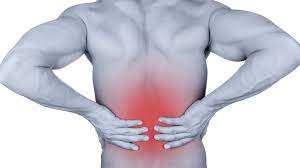
Stay informed. Find us on Facebook and leave your like.
Non-specific low back pain is defined as common low back pain not attributable to a recognizable, known specific pathology (eg, infection, tumour, osteoporosis, lumbar spine fracture, structural deformity, inflammatory disorder,radicular syndrome, or cauda equina syndrome).
Non-specific low back pain is usually categorized in 3 subtypes: acute, sub-acute and chronic low back pain. This subdivision is based on the duration of the back pain. Acute low back pain is an episode of low back pain for less than 6 weeks, sub-acute low back pain between 6 and 12 weeks and chronic low back pain for 12 weeks or more.
Low back pain (LBP) is the fifth most common reason for physician visits, which affects nearly 60-80% of people throughout their lifetime[6][7]. The lifetime prevalence of low back pain is reported to be as high as 84%, and the prevalence of chronic low back pain is about 23%, with 11-12% of the population being disabled by low back pain[1]. In the 2010 Global Burden of Disease study the global age-standardised point prevalence of LBP (from 0 to 100 years of age) was estimated to be 9.4%[8]. The same study showed that prevalence in 2010 was highest in western Europe followed by North Africa/Middle East, and lowest in the Caribbean followed by central Latin America.
Economically LBP is a huge burden, LBP causes more global disability than any other condition[8]. The cost of care for LBP has been reported (in the USA) to be over $50 billion annually[9]. Despite the intense focus and formal research on the care of non-specific LBP Pransky et al[10] reported a five fold increase in the prevalence of LBP over a 15 year period. It should be noted that most of the epidemiology/economic studies have been done in the western industrialised higher resourced countries and these figures will differ globally.
Low back pain is a self limiting condition[11]:
- 90% of people with LBP will recover in 3-4 months with no treatment.
- 70% of people with LBP will recover in 1 month with no treatment.
- 50% of people with LBP will recover in 2 weeks with no treatment.
- 5% of the remaining 10% will not respond to conservative care (such as physiotherapy)
- The final 5% are the more challenging cases that don’t naturally improve that we as physiotherapists commonly see.
However these figures may be deceptive because although the pain may go away the the re-occurrence rate of LBP is extremely high and these individuals are likely to experience another episode of LBP within 3-6 months. Re-occurrence is a major problem with the re-occurrence rate being approximately 60%.
Non-specific low back pain accounts for over 90% of patients presenting to primary care[12] and these are the majority of the individuals with low back pain that present to physiotherapy.
Non-specific low back pain can caused by:
- Traumatic injury
- Lumbar sprain or strain
- Postural strain
Cook et al (study ongoing 2015) studied risk factors for LBP pain:
| First occurrence | Recurrent episode | |
| Community setting | standing or walking >2hrs per dayfrequent moving or lifting >25 lbswidespread painlimpinghigher general health scores | other musculoskeletal complaintssitting, standing or walking >2hrs per dayfrequent moving or lifting >25 lbsstrength <50%depressionperceived inadequacy i.e. income, job |
| Occupational setting | femaleobesityincreased driving timeperceived heavy lifting requirementsslower velocity doing activitiespoor MCS SF-12 score (i.e. higher anxiety, depression etc) | obesitypoor healthprior LBPpoor back endurancefrequent moving or lifting >25 lbsmanual jobsawkward posturemental distresspoor relationships at work |
Leg pain is a frequent accompaniment to low back pain, arising from disorders of neural or musculoskeletal structures of the lumbar spine. Differentiating between different sources of radiating leg pain is important to make an appropriate diagnosis and identify the underlying pathology. Some specific causes of leg pain need to be managed in a different way to simple non-specific low back pain.
Low back pain is a symptom that accompanies several diseases. The diagnosis of non-specific low back pain implies no known pathoanatomical cause. Triage aims to exclude those cases in which the pain arises from either problems beyond the lumbar spine (eg, leaking aortic aneurysm); specific disorders affecting the lumbar spine (eg, epidural abscess, compression fracture, spondyloarthropathy, malignancy, cauda equina syndrome); or radicular pain, radiculopathy, or spinal canal stenosis. Remaining cases are non-specific low back pain. Several lumbar structures are plausible sources of pain (eg, the intervertebral disc, the facet joints), but clinical tests do not reliably attribute the pain to those structures.
Key message: The diagnosis of non-specific low back pain implies no known pathoanatomical cause.
Non-specific low back pain is defined as low back pain not attributable to a recognizable, known specific pathology. The place for surgery in chronic non-specific low back pain is very limited and its overuse has been criticized. Level of evidence 1A
For acute low back pain, most clinical practice guidelines agree on the use of reassurance, recommendations to stay active, brief education, paracetamol, non-steroidal anti-inflammatory drugs, spinal manipulation therapy, muscle relaxants (as second line drugs only, because of side-effects), and weak opioids (in selected cases). Level of evidence 1A
For chronic low back pain, the use of brief education about the problem, advice to stay active, non-steroidal anti-inflammatory drugs, weak opioids (short-term use), exercise therapy (of any sort), spinal manipulation are recommended and Self-management strategies. Level of evidence 1A
Source: https://www.physio-pedia.com/Non_Specific_Low_Back_Pain



